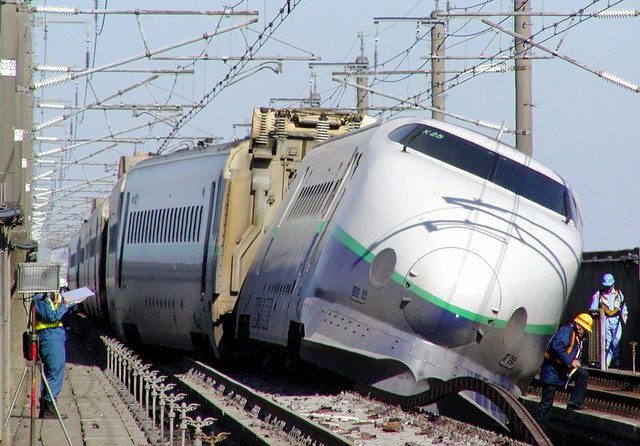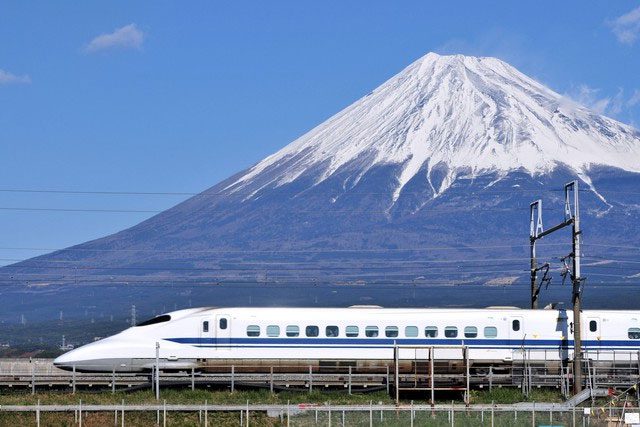East Japan Railway Company is upgrading its earthquake early warning system to enhance the rapid response capabilities of Shinkansen trains during seismic events. This system is expected to be implemented across all 135 Shinkansen trains operating on the Tohoku, Joetsu, and Hokuriku lines by March 2024.
According to a press release, the new system will reduce the response time from the moment an earthquake is detected to the activation of emergency brakes from the current average of 3.9 seconds to just 1.3 seconds.
When an earthquake of magnitude 5.5 Richter or higher is detected, the emergency brakes will be automatically activated. This system has been developed based on joint research with the Railway Technical Research Institute, allowing a Shinkansen train traveling at a speed of 320 km/h to stop within approximately 230 meters, a shorter distance compared to current technology.

Shinkansen is Japan’s pioneering high-speed passenger rail system. (Illustrative image).
The railway operator also announced that it is reevaluating its current calculations used to predict earthquake magnitudes via P-waves—primary waves that travel faster than S-waves, which cause ground movement—to improve the accuracy of forecasts.
Currently, Shinkansen trains must stop approximately 20 times a year due to earthquake-related issues. With the new system, it is anticipated that the number of emergency stops will increase by an additional four times due to the enhanced sensitivity of the system.
At a press conference, JR East President Yuji Fukasawa described this as a “decision to prioritize safety even further.” The Shinkansen safety system in the event of earthquakes has been continuously improved since its initial implementation in 1982.
World’s Safest High-Speed Rail System
Shinkansen, also known as “New Main Line” in Japanese, is Japan’s pioneering high-speed passenger rail system, serving the islands of Honshu, Kyushu, and Hokkaido. Originally constructed and operated by the state-owned Japanese National Railways, this system has been managed by the Japan Railway Group since 1987.
Shinkansen trains are electric multiple units, capable of carrying 1,000 passengers or more, powered by an overhead electrical system. Initially, the maximum speed was 210 km/h, later increased to between 240 and 300 km/h. By early 2013, some trains were operating at speeds of up to 320 km/h. The high speeds necessitate the development of advanced safety features, especially in earthquake situations.
During the major earthquake in 2011, a seismometer at Kinkazan sent an automatic stop signal to the Shinkansen’s power transmission system, activating emergency brakes on 33 trains, preventing severe damage and casualties. This system is part of the UrEDAS emergency earthquake warning system, which includes seismometers installed at 97 locations across Japan. When the seismometers detect vibrations from an earthquake, they assess the expected impact and send a warning signal to cut power to the trains.

Shinkansen trains are electric multiple units. (Illustrative image).
Additionally, Japan’s Shinkansen utilizes advanced braking systems to ensure safety and efficiency, especially when traveling at high speeds. This system includes aerodynamic brakes, which increase aerodynamic drag and reduce the train’s speed without relying solely on friction between the wheels and rails, particularly beneficial in adverse weather conditions or emergency situations like earthquakes.
The prototype of the aerodynamic braking system has been tested in wind tunnels at wind speeds of up to 400 km/h. During testing, a maximum drag force of 2.3 kN (3.5 kN in the tunnel) can be achieved within just 0.3 seconds after activation. The durability of the equipment has been validated through continuous operation at high speeds over long periods, with no issues reported, including the absence of aerodynamic noise when the brakes are retracted.
Moreover, Shinkansen is also equipped with traditional braking systems featuring cast iron brake discs and metal linings designed to withstand strong braking forces without deformation. Additionally, all train operations are monitored and controlled from a central computer in Tokyo, ensuring optimal safety and efficiency. The braking system combines pneumatic brakes and regenerative brakes to enhance braking performance and energy savings.
Furthermore, all train operations are monitored and controlled from a central computer in Tokyo, ensuring optimal safety and efficiency. The trains are also equipped with a lithium-ion battery-powered autonomous system – the first of its kind in the world. This system allows the train to travel a short distance without external power and can move to a safe location at low speeds if stranded in a high-risk area, such as on a bridge or in a tunnel, during an earthquake.
These safety measures and technological advancements work together to ensure the safety of passengers on Japan’s bullet trains during earthquake events, maintaining Shinkansen’s reputation as one of the safest and most reliable high-speed rail systems in the world.




















































